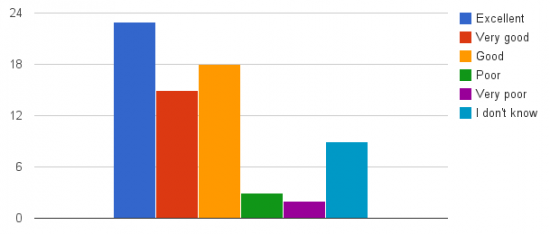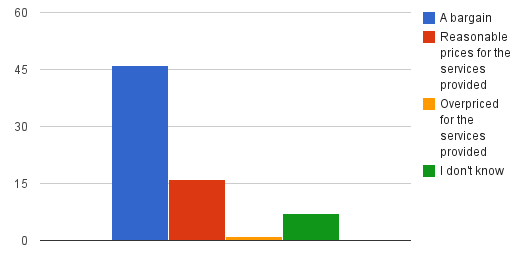Vehicle physics topped the list of missing features in our survey of OpenSim hosting providers this week.
Because of the holiday — and the short notice — only 70 people responded to the survey, compared to last year’s 114. Of those, 52 percent said that vehicle physics was among the features they most missed in OpenSim. This was followed by content and search, at 29 percent each, with community next at 25 percent. Numbers add up to more than 100 percent because respondents could select more than one feature.

Script-based vehicles are widely available on many grids, including OSGrid, InWorldz, and Island Oasis. But it seems that OpenSim vendors should try to get together and solve the physics issues — or pitch in and hire someone to do it.
As far as favorite OpenSim features went, the responses were pretty evenly split. The vast majority — 70 percent — liked the low prices, 65 percent liked being able to save copies of their regions, 62 percent liked the fact that OpenSim was open source software, 55 percent liked the ability to make hypergrid teleports to other grids, and 54 percent liked the ability to save copies of their inventories. Â Numbers add up to more than 100 percent because respondents could select more than one feature.
Vendors offering these features to their hosting companies would do well to highlight them in their marketing materials.

As was the case last year, the overwhelming majority — 82 percent — said they would “absolutely recommend” OpenSim to others, about the same percentage as last year. (We didn’t count two votes because they said they would “absolutely not recommend” but rated their vendors as “excellent” — possibly a mistake in filling out the survey.)

The majority of respondents said that stability of their regions or grids — how little they crashed — was “absolutely reliable” or “very reliable”.

We also asked the respondents to rate Second Life, as a measure of comparison.

This supports other reports we’ve heard from OpenSim users: When they run up-to-date OpenSim on adequate hardware, their regions rarely if ever crash or have other problems. And if a region does need to be down for a period of time — say, for a backup or upgrade — the maintenance takes place on the user’s schedule, not that of some other company. This is a major benefit for schools and companies holding scheduled events on their virtual land.
Similarly, the majority said that the performance of their regions — how little lag they saw — was “excellent” or “very good.”

However, this performance should be considered in combination with the use these regions get. The vast majority of respondents said they had little to light traffic on their regions or grids.

However, all respondents who said that their regions saw “very heavy” or “extreme” traffic said that the stability of their regions or grids were “reliable” or “very reliable” and their performance “very good” or “excellent.”
OpenSim allows users — or their hosting companies — to allocate additional resources to heavily-used regions, and to run them as independent process, so that activity on other regions doesn’t affect their performance. Again, this is a useful tool for companies and school, allowing them to plan ahead for large events.
Our readers were overwhelmingly positive about the support they receive from their hosting companies, a sign that OpenSim vendors are, overall, paying close attention to their customers. Those who ran their own grids or regions said they received support from the OpenSim community.

We asked our readers about the user interfaces that their hosting companies provided. OpenSim allows vendors to offer grid or region management tools through Web interfaces. For example, some hosting providers allow users users to save a copy of their entire region to their harddrive with the click of a button. Other common tasks include restarting regions, creating new users, turning hypergrid on or off, starting up new regions, and even managing private currencies.

Many vendors are still in the process of developing their management panels and Web front ends, so the overall scores are a little lower here than for support.
And it’s no surprise that folks are pretty happy with the prices they see for OpenSim.

This isn’t a big shocker — OpenSim is free for those with the technical skills to run and manage the software. And commercial hosting starts at $6 per region, with even high-end, high-performance regions available for under $100 each — with plenty of bulk discounts available. Most vendors charge little or nothing to set up new regions.
By comparison, Second Life charges around $300 per region per month, with $1,000 to set up a new region.
Vendor breakdown
We’re not going to provide individual data for the vendors, because there were too few responses for each vendor to have any statistical significance.
In addition, more than half — 54 percent — said they were running their own regions or grids. About 33 percent said they were running standard OpenSim, 9 percent said they were running the Diva Distro, and more than 11 percent said they were running Sim-on-a-Stick.
Of the rest, eight people said they used Virtyou, which offers both private grids as well as rents out land on it’s own, Virtyou grid. Many respondents rated them on their grid, not on their hosting. Nova had seven respondents. Dreamland Metaverse had three respondents, as did YourSimSpot and MA Rentals. JokaydiaGrid and ReactionGrid, which also host their own grids and provide hosting to private grids, had two respondents each. There were also two responses for SimHost and one for TalentRaspel.

What this data probably shows is that people who run their own OpenSim read Hypergrid Business more often, to stay on top of what’s happening with the technology, than do folks who have vendors run it for them. Or, perhaps, they are more technically inclined and more likely to check their Twitter and RSS feeds over the holiday week and see that there’s a survey being conducted.
We’ll try to redo this survey again in the late spring to get a more accurate indication of how people feel about OpenSim vendors.
Meanwhile, some quotes from the respondents:
Running their own OpenSim
“Â I run a full virtual server provided by a hosting company and run the latest Opensim code. I have full remote access so all options are open to me. I can control everything this way and allocate resources as needed.”
“Decent server plus decent connection plus decent info equals happier than ever been in Second Life.”
“Support is outstanding because I ask the community and get immediate feedback.”
“I use Sim-on-a-Stick for conference workshops … with as many as 24 participants. I have also used it on a couple of corporate projects as a tool for doing product placement proposals and to create elearning training videos. These two projects have earned my company $260,000 — reminiscent of the heydays of Second Life in 2005!”
Nova
All respondents except one said they would “absolutely” recommend it to others, citing support and personal service. One reader, however, was unhappy with their hosting, citing a sim that was down for a long time with no refund. “It happened after three months of bad performance on Aurora-Sim and OpenSim,” the reader added.
SimHost
“We had 42 people … log into our grid for an hour and a half over the summer without incident — we still had 2 gigs of RAM free and that CPU never went above 20 percent.”
- Kitely Mega Worlds on sale for $90 per month - July 19, 2024
- OpenSim regions up, actives down with summer heat - July 15, 2024
- People think AIs are conscious. What could this mean for bots in OpenSim? - July 12, 2024
